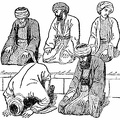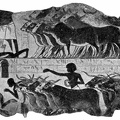The dress of the men of the middle and higher classes consists of the following articles.
First, a pair of full drawers of linen or cotton, tied round the body by a running string or band, the ends of which are embroidered with coloured silks, though concealed by the outer dress. The drawers descend a little below the knees, or to the ankles; but many of the Arabs will not wear long drawers, because prohibited by the Prophet.
Next is worn a shirt, with very full sleeves, reaching to the wrist; it is made of linen, of a loose, open texture, or of cotton stuff, or of muslin or silk, or of a mixture of silk and cotton, in stripes, but all white. Over this, in winter, or in cool weather, most persons wear a “sudeyree,” which is a short vest of cloth, or of striped coloured silk and cotton, without sleeves. Over the shirt and sudeyree, or the former alone, is worn a long vest of striped silk and cotton (called “kaftán,” or more commonly “kuftán”), descending to the ankles, with long sleeves extending a few inches beyond the fingers’ ends, but divided from a point a little above the wrist, or about the middle of the fore-arm; so that the hand is generally exposed, though it may be concealed by the sleeve when necessary, for it is customary to cover the hands in the presence of a person of high rank. Round this vest is wound the girdle, which is a coloured shawl, or a long piece of white figured muslin. The ordinary outer robe is a long cloth coat, of any colour (called by the Turks “jubbeh,” but by the Egyptians “gibbeh”), the sleeves of which reach not quite to the wrist.Some persons also wear a “beneesh,” or “benish,” which is a robe of cloth, with long sleeves, like those of the kuftán, but more ample
- Author
- An account of the manners and customs of the modern Egyptians
By Edward William Lane
Written in Egypt during the Years 1833-1835
Available from gutenberg.org - Posted on
- Sunday 21 May 2023
- Dimensions
- 400*688
- Albums
- Places / Middle East / Egypt
- Visits
- 1859
- Downloads
- 31
 Download Photo
Download Photo





